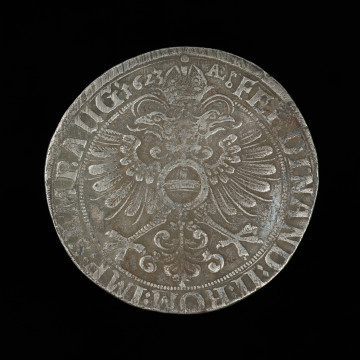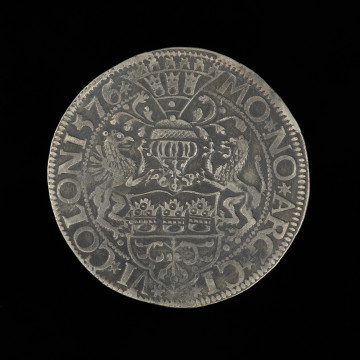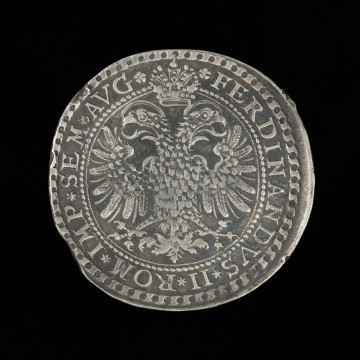
Thaler of the Reich
1623
National Museum in Szczecin
Part of the collection: German coins
Since the Middle Ages, Nuremberg has been one of the most important cities in Germany. In 1219, thanks to the privilege issued by Emperor Frederick II (1194-1250), it became a free city governed by burgraves. In 1427 the burgrave sold his office to the city, which opened the way for Nuremberg to become fully independent. With growing wealth, the city began minting silver coins. The mass minting of thalers took place in the first half of the 17th century and during the Thirty Years' War, featuring a very characteristic type of the reverse, created in 1594, depicting escutcheons arranged into a triangle. The left side always featured the grand coat of arms of the city (an escutcheon with the frauenadler – a maiden-eagle. To the left was the lesser coat of arms – an escutcheon with two vertical fields, with half of the imperial eagle and bends, and the escutcheon above denoted the so-called direct imperial rule. Depending on the issue, it was either a single-headed eagle (the mark of the King of Rome) or a double-headed eagle (the mark of the Roman King and the German Emperor). The displayed thaler features a putto holding the municipal coats of arms, with an olive branch on its sides – a symbol of peace and hope, and a palm branch – a symbol of victory. Earlier coins featured a putto with wings, resembling a cupid. On this coin, the putto does not have wings, and the top escutcheon features a coat of arms of the King of Rome. Thus, Nuremberg used a unique design of their coin reverses. Due to the fact that in heraldry, greater and lesser coats of arms usually consist of similar elements, the use of both on the same coin, and on the same side, is highly unusual. Featuring both coats of arms on coins became somewhat of a tradition in Nuremberg, distinguishing its thalers. This rule was still in force in the case of some of the coins minted in the mid-18th century.
Mieszko Pawłowski
Other names
Reichstaler
Author / creator
Dimensions
cały obiekt:
Object type
coin, money
Technique
minting
Material
silver
Creation time / dating
Creation / finding place
Owner
National Museum in Szczecin
Identification number
Location / status

1623
National Museum in Szczecin

1576
National Museum in Szczecin

1624
National Museum in Szczecin
DISCOVER this TOPIC
Museum of King Jan III's Palace at Wilanów
DISCOVER this PATH
Educational path